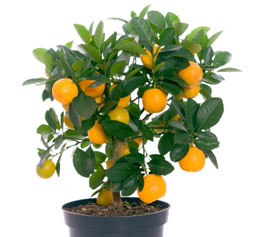As the name rightly suggests, dwarf fruit trees are small-sized trees that produce regular fruits. This article provides some information about these fruit trees.

A dwarf fruit tree is a small tree, which bear fruits of regular size. They are perfect for small backyard gardens, patios and balconies. According to the dwarfing procedure, these trees can be classified into regular and genetic dwarfs. While some varieties can be grown in containers, others can be planted on the ground. You have to choose them, according to your requirements.
Regular Dwarfs
Regular dwarfs are made by grafting a scion (full-size top of a plant) of a regular-size fruit variety to the rootstock of another variety. The fruit size of the resultant tree depends on the scion and the rootstock will be responsible for the degree of dwarfism. 'Ultra-dwarf' rootstock create trees with a height of 3 to 6 feet, whereas the height of trees made from 'semi-dwarf' variety will range between 6 to 15 feet. Sometimes, the process may require a stem of another plant (interstem), to be grafted between the scion and the rootstock. This is done for enhancing the graft compatibility and disease resistance.
Genetic Dwarfs
Genetic dwarfs are trees made by grafting compact trees onto regular rootstock. The compact trees are already small; and can be grown on their own roots, but drafting is usually done to increase resistance to pests and diseases. Fully grown genetic dwarfs do not exceed a height of six feet, which makes them perfect for container gardening. These trees are muscular, with many leaves and growth buds. The genetic dwarfs of peach, nectarine and apple, and commonly available.
Advantages
The main advantage of dwarf fruit trees is the space factor. You can plant more trees in a lesser space. You may also grow different varieties of dwarf fruit trees in a small area. It is easier to prune and harvest dwarf trees, as compared to their counterparts. Dwarf fruit trees bear fruits much earlier than the regular trees. Some of these trees can be grown in containers that can be kept in balconies or patios. You need only small amounts of pesticides for dwarf trees. The fruits of dwarf trees are like regular fruits, as far as their size is concerned.
It is really easy to take care of dwarf fruit trees. You have to adjust the light (sunlight) conditions according to the requirement of individual varieties. Some trees need good sunlight for growth, while some prefer shade. If your tree is planted in a container, you may shift the location; or else, plant the trees in appropriate locations. Pruning has to be done just before spring, as active growth of the tree starts with this season. Summer pruning can also be done to prevent unwanted growth, and to maintain the small size. Frequent fertilization is needed, but watering should be done only when required. Repotting has to be done in every two years.
If you are interested in planting fruit trees and you have a limited space, then dwarf fruit trees can be the perfect choice. It is always better to gain a thorough knowledge about the right trees and their requirements beforehand. You may consult a horticulturist or the local nursery authorities, for this purpose.






 A dwarf fruit tree is a small tree, which bear fruits of regular size. They are perfect for small backyard gardens, patios and balconies. According to the dwarfing procedure, these trees can be classified into regular and genetic dwarfs. While some varieties can be grown in containers, others can be planted on the ground. You have to choose them, according to your requirements.
A dwarf fruit tree is a small tree, which bear fruits of regular size. They are perfect for small backyard gardens, patios and balconies. According to the dwarfing procedure, these trees can be classified into regular and genetic dwarfs. While some varieties can be grown in containers, others can be planted on the ground. You have to choose them, according to your requirements.